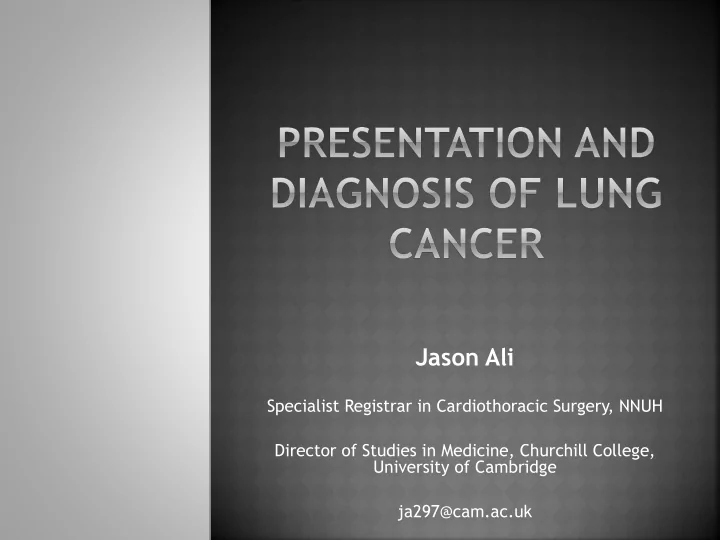

Jason Ali Specialist Registrar in Cardiothoracic Surgery, NNUH Director of Studies in Medicine, Churchill College, University of Cambridge ja297@cam.ac.uk
Understand the presentation of lung cancer Understand the steps and investigations required to diagnose lung cancer Understand the decision making processes in managing these patients Consider screening for lung cancer
Leading cause of cancer-related death in the world Male:female ratio 6:5 Male incidence decreasing, female increasing 75% patients present with symptoms due to advanced disease not amenable to cure 5-year survival rate is just 16%
Smoking history positive in at least 85-90% Occupational exposure e.g. asbestos, silica, uranium Radon gas Air pollution Genetic – hereditary predisposition
Cough Dyspnoea Recurrent/persistent pneumonia Haemoptysis Chest pain Shoulder/arm pain
Airway obstruction Superior vena cava obstruction Hoarse voice due to recurrent laryngeal nerve invasion Dyspnoea due to pleural or pericardial effusion
Brain – headache, seizure Bone – pain Liver - pain Adrenal – insufficiency/haemorrhage Lung – dyspnoea/haemoptysis
= is a syndrome that is the consequence of cancer in the body but that, unlike mass effect, is not due to the local presence of cancer cells. These phenomena are mediated by humoral factors (by hormones or cytokines) excreted by tumour cells or by an immune response against the tumour.
Hypercalcaemia – squamous cell carcinoma Acanthosis nigricans Syndrome of inappropriate anti-diuretic hormone secretion (SIADH) Cushings syndrome – excessive ACTH secretion Lambert-Eaton syndrome
Imaging for some other reason
Persistent cough for more than three weeks Pleuritic chest pain Dyspnoea Haemoptysis Persistent nocturnal cough Wheeze Recurrent chest infections Unintentional weight loss 2-week wait referral
What questions are important to ask? Explore red-flag symptoms of lung cancer Explore symptoms described above Smoking? Exposure to risk factors? Family history?
May demonstrate: Primary tumour Lymph node involvement Metastatic disease Pleural effusion Obstructive pneumonia/atelectasis
Allows assessment of: Primary lesion Site Size Local spread Lymph node involvement Presence of metastatic disease
To confirm type of lung cancer CT guided Bronchoscopic Endobronchial ultrasound guided
Small cell carcinoma (15%) Non-small cell carcinoma Adenocarcinoma (40%) Squamous cell carcinoma (25%) Large cell carcinoma (10%) Carcinoid tumour (a neuroendocrine tumour)
Malignant neuroendocrine epithelial tumour consisting of small cells Tend to be: Centrally located Associated with paraneoplastic syndromes Exhibit aggressive behaviour: rapid growth and early metastasis Very chemo and radio- sensitive
Adenocarcinoma Glandular structures
Squamous cell carcinoma Keratin pearls
Large cell carcinoma Absence of morphological features of the above
Multidisciplinary team meeting Members? Respiratory physician Radiologist Histopathologist Oncologist Thoracic surgeon Lung cancer specialist nurse Palliative care team
Further investigations: Staging Operability Management options: Surgery Oncology Palliative care Focus of next lecture
a strategy used in a population to identify the possible presence of an as-yet- undiagnosed disease in individuals without signs or symptoms. This can include individuals with pre-symptomatic or unrecognized symptomatic disease. As such, screening tests are somewhat unique in that they are performed on persons apparently in good health - enabling earlier intervention and management in the hope to reduce mortality and suffering from a disease
Pap smear or liquid-based cytology to detect potentially precancerous lesions and prevent cervical cancer Mammography to detect breast cancer Colonoscopy and faecal occult blood test to detect colorectal cancer
WHO 1968 The condition should be an important health problem. There should be a treatment for the condition. Facilities for diagnosis and treatment should be available. There should be a latent stage of the disease. There should be a test or examination for the condition. The test should be acceptable to the population. The natural history of the disease should be adequately understood. There should be an agreed policy on whom to treat. The total cost of finding a case should be economically balanced in relation to medical expenditure as a whole. Case-finding should be a continuous process, not just a "once and for all" project.
National Lung Screening Trial Prospective, randomised controlled trial between 2002 and 2004, reporting in 2011 Assessing patients at high risk for lung cancer in USA Group 1: annual screening with low-dose CT Group 2: single CXR Group 1: relative reduction in mortality from lung cancer of 20%. 6.7% reduction in rate of death from any cause. Trial stopped early
UK Lung Cancer Screening Trial Aiming to identify 4000 high risk patients who will be randomised to receive a low dose CT scan Outstanding questions: Cost effectiveness Identifying patients at risk
Detection of nodules, majority of which are benign NLST – 96% of abnormal results false positive Radiation from serial imaging Prolonged follow-up of nodules – anxiety of patients Some tumours would not have affected mortality during the patients lifetime ‘ overdiagnosis ’
Lung cancer is a common disease The majority of patients present with advanced disease Lung cancer diagnosis and management is a multidisciplinary process and involves a variety of imaging modalities Prevention is likely to have a far greater impact on lung cancer mortality than is screening
Recommend
More recommend